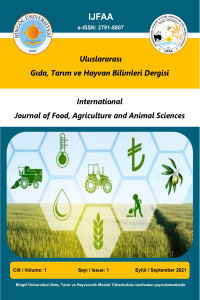Tolga SARIYER, Çağlar KAYA, Mehmet Ali GÜNDOĞDU, Esra ŞAHİN, Hatice Nihan ÇİFTCİ, Fatih Cem KUZUCU, Yavuz ALKAN
Determination of the Effects of Different Tree Logs on Yield and Some Quality Properties in Oyster Mushroom (Pleurotus ostreatus (Jacq.) P. Kumm.)
Determination of the Effects of Different Tree Logs on Yield and Some Quality Properties in Oyster Mushroom (Pleurotus ostreatus (Jacq.) P. Kumm.)
Oyster mushroom (Pleurotus spp.), which is the second most cultivated mushroom species in the world after the cultivated mushroom (Agaricus bisporus), can be grown at lower temperatures than other species and needs less specific ecological factors, making it easier to cultivate. In the current study, oyster mushroom (Pleurotus ostreatus) was grown in substrates prepared by using logs of beech (Fagus spp.), chestnut (Quercus spp.), poplar (Populus spp.), and linden (Tilia spp.) trees. In this context, the study was carried out in the mushroom production room of Canakkale Onsekiz Mart University, Faculty of Agriculture, Department of Horticulture. In the study, yield, fruit characteristics, protein amount, soluble solids, pH, TETA (Titratable acidity) and flavor value were determined. It was observed that Pleurotus ostreatus micelles did not spread on the linden logs during the incubation stage. When other logs were evaluated, it was determined that beech, poplar and chestnut logs were more suitable for oyster mushroom cultivation in terms of yield, respectively. While the lowest protein value was obtained in the beech log substrate, the highest protein value was obtained in the chestnut log substrate. In terms of external appearance, it can be said that beech and poplar logs have similar and more suitable values. In terms of the study results, beech medium can be recommended for cultivation with the aim of high
Keywords:
Pleurotus ostreatus, log substrate, protein component, yield,
___
- Akyüz, M., İnci, Ş. & Kırbağ, S. (2021). Nutritive value of (Pleurotus ostreatus (Jacq.) P. Kumm.) grown on some cellulosic residues. Orman Fakültesi Dergisi, 22 (2), 218-221.
- Avcı, S. (2015). Farklı ağaç türlerine ait talaş ortamlarının Pleurotus ostreatus mantarının verimi, kalitesi ve antimikrobiyal aktivitesi üzerine etkileri. Biyoloji Anabilim Dalı, Yüksek Lisans Tezi, Recep Tayyip Erdoğan Üniversitesi, Fen Bilimleri Enstitüsü, Sayfa: 52.
- Baydaş, F. & Altuntaş, E. (2019). İstiridye mantarının (Pleurotus ostreatus) bazı biyoteknik özellikleri ve kurutma karakteristiklerinin belirlenmesi. Mantar Dergisi, 10 (Özel Sayı), 119-136.
- Boztok, K. & Erkip, N. (2002). Meşe Mantarının (Lentinula edodes) ağaç kütükleri üzerinde yetiştiriciliği. Ege Üniversitesi Ziraat Fakültesi Dergisi, 39 (1), 149-155.
- Doğan, M. (2019). Kütükte istiridye mantarı [Pleurotus ostreatus (Jaq.) P. Kumm.] üretiminin ekonomik analizi. Kastamonu Üniversitesi, Fen Bilimleri Enstitüsü, Yüksek Lisans Tezi, 1-54.
- Emir, F. (1998). Farklı yıkama çözeltisi ve ambalaj malzemesinin modifiye atmosferde depolanan kültür mantarı (Agaricus bisporus) kalitesine etkileri. İstanbul Teknik Üniversitesi, Fen Bilimleri Enstitüsü, Yüksek Lisans Tezi, 42 s.
- Grace, J. & Mudge, K.W. (2015). Production of Hericium sp. (Lion’s Mane) mushrooms on totem logs in a forest farming system. Agroforest Syst., 89, 549-556.
- Hoa, H.T., Wang, C.L. & Wang, C.H. (2015). The effects of different substrates on the growth, yield, and nutritional composition of two oyster mushrooms (Pleurotus ostreatus and Pleurotus cystidiosus). Mycobiology, 43 (4), 423-434.
- Kırbağ, S. & Korkmaz, V. (2014). Değişik tarımsal atıkların bazı kültür mantarı türlerinin besin değerleri üzerine etkisi. Artvin Çoruh Üniversitesi. Orman Fakültesi Dergisi, 5 (2), 126-131.
- Kurt, Ş. (2008). Değişik tarımsal artıkların kayın mantarı (Pleurotus ostreatus, Pleurotus sajor-caju) yetiştiriciliğinde kullanım olanakları. Doktora Tezi. Çukurova Üniversitesi. Fen Bilimleri Enstitüsü, 1-212.
- Martinez-Carrera, D. (1998). Cultivation of oyster mushrooms. McGraw-Hill Yearbook of Science & Technology New York: Ed.: M. D. Licker. McGraw-Hill, pp. 242-245. ISBN 0-07-052625-7.
- Onyeka, E.U., Udeogu, E., Umelo, C. & Okehie, M.A. (2017). Effect of substrate media on growth, yield and nutritional composition of domestically grown oyster mushroom (Pleurotus ostreatus). African Journal of Plant Science, 12 (7), 141-147.
- Pekşen, A. (2013). Kayın mantarı (Pleurotus ostreatus): Kütük yetiştiriciliği. Samtim, 18-20.
- Sanchez, C. (2010). Cultivation of Pleurotus ostreatus and other edible mushrooms. Applied Microbiology and Biotechnology, 85, 1321-1337.
- Sözbir, G.D. (2021). İstiridye mantarının (Pleurotus ostreatus) yetiştirilmesinde bazı endüstriyel atıkların kullanım olanaklarının belirlenmesi. Turkish Journal of Forest Science, 5 (1), 187-197.
- Tisdale, T.E., Miyasaka, S.C. & Hemmes, D.E. (2013). Cultivation of the Oyster Mushroom (Pleurotus ostreatus) on Wood Substrates in Hawaii. World Journal of Microbiology & Biotechnology, 22, 201-206.
- Başlangıç: 2021
- Yayıncı: Bingöl Üniversitesi
Sayıdaki Diğer Makaleler
Biyotasarımda yeni bir perspektif: Böcekler
Şahika BEKTAŞ, Nilay GÜLPERÇİN, Serdar TEZCAN
Tolga SARIYER, Çağlar KAYA, Mehmet Ali GÜNDOĞDU, Esra ŞAHİN, Hatice Nihan ÇİFTCİ, Fatih Cem KUZUCU, Yavuz ALKAN
Küresel İklim Değişikliğinin Bingöl İli Aylık ve Yıllık Yağış Miktarlarına Etkisi
Erzurum İli’nde Küçükbaş ve Büyükbaş Hayvancılığın Mevcut Durumu ve Meralar Açısından Potansiyeli
Antik Buğday Siyez’in (Triticum monococcum) Ekmeğin Kalite ve Besinsel Özelliklerine Etkisi
Hayvancılık İşletmelerinde Sürü Yönetimi, Otomasyon ve Yapay Zeka Uygulamaları
